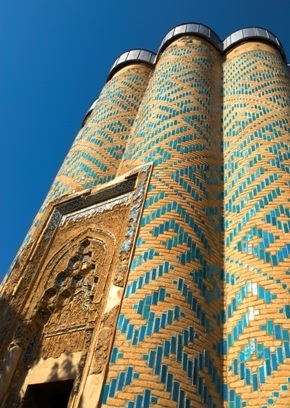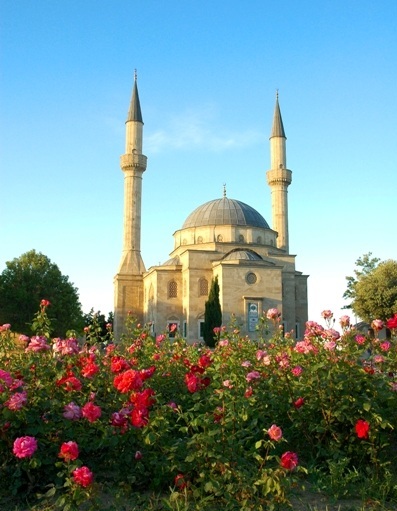People often ask me what my favorite type of food is. Truth be known, I have no favorite, or rather, my favorite changes so often that it is impossible to say what it is for very long. No matter how many times I’m asked, however, the cuisine of Azerbaijan is always one of my top choices – at least when considering the cuisines from Volume One of The Silk Road Gourmet.
One of the reasons I like Azeri food so much is that there is interplay of so many different traditions evident in the flavors. The most obvious influence is found from Persian food in a nearly full complement of the main western Asian ingredients: saffron, sumac, fenugreek, cumin, marigold, and sour plums, sour grapes, sour cherries and pomegranates. European influences can be seen cilantro and coriander seeds, mint, savory, red vinegar. Central Asian items include onion, garlic and dill; Indian subcontinent ingredients include cardamom, sweet basil and cinnamon and from the Pacific Rim we have nutmeg and cloves.
The unique combinations of these ingredients in Azeri food are remarkable and wonderful and provide what I like to call – taste revelations: Baked Fish with Sour Cherries, Hens with Dill and Pomegranates, Lamb with Quinces and Capers, Cinnamon Potatoes with Pine Nuts . . . Hungry yet?
Situated on the western coast of the Caspian Sea, Azerbaijan is another one of the Asian continent’s strategic crossroads between east, west, north, and south. As such, it has been occupied by many foreign rulers and peoples who have left their mark on its modern culture. As with its Georgian and Armenian neighbors, influences as diverse as those of Rome, Alexander, the Uzbek Tamerlane, and Genghis Khan, can be found—both in and outside of the kitchen.
Like Georgia, Azerbaijan has a wide variety of climatic zones as well. In fact, nine of eleven climatic zones are represented, and in Azerbaijan one can simultaneously see all four seasons just by traveling from one end of the country to the other. High mountains, fertile foothills growing tea and citrus, dry steppes, luxurious forests, and Caspian shores—Azerbaijan has it all! So, in addition to a long history of foreign occupation, a widely varied climate has led to one of western Asia’s most diverse cuisines.
Archaeological evidence of habitation goes back to the upper Paleolithic with the caves and petroglyphs of Gobustan. The gold-forging, Scythian horsemen dwelt there in the 9th Century BCE and were followed by the Medes until the 6th Century BCE. The country was incorporated into the Persian Achaemenid Empire by the 5th Century BCE, and quickly became a major center for the Zoroastrian faith because of the natural upwelling of gas fires that allowed them to build many fire-temples.
The Sassanid Persians ruled from the 2nd Century CE to the Muslim Arab conquest of the mid-7th Century. The Umayyad or the Abbasids ruled until the 13th Century, but beginning in the 11th Century Central Asian tribes, dominated by the Oghuz Turkmen seized the reigns of power. A western branch of the Oghuz, the Seljuks rose to prominence and ushered in a time of intellectual and cultural flowering throughout the empire.

The Seljuks favored an early, angular form of Arabic calligraphy called Kufic script that is often depicted in a maze-like square called square or geometrical Kufic and is used in architecture and textile design throughout the Muslim world. The fascinating thing about square Kufic is that it is a true child of Silk Road cultural exchange. It arose after Muslim traders had regular contact with Chinese merchants and admired their square “seals” used to identify individuals on contracts and shipments of goods. Kufic squares are formed by arranging lines of Kufic script in a square pattern, sometimes by arranging words and phrases in a spiral form. Usually the words depict verses from the Koran or the name of God or the prophet Mohammed or Imam Ali. These squares are then repeated in a pattern to form amazing lattice-like designs like those seen on Azerbaijan’s Mausoleum Gudi Khatun or in the border of the Azeri Kuba Afshan rug that graces the Kelley-family living room floor.
The Seljuks first became a vassal state to the Mongols who ruled from about 1220 to the early 1300s. After the Mongols, the Jalayirids,ruled for about 100 years, followed by Timur or Tamerlane who reinstated patronage of Persian and Muslim cultural and intellectual pursuits. After Timur’s death in 1405, the local Shirvanshah – present in the region for hundreds of years – rose to prominence. The Safavids introduced Sh’ia Islam and were followed by a series of Khanates that persisted until the early 19th Century when they were incorporated into the Russian Empire. Except for a brief couple of years as the Azerbaijan Democratic Republic, Azerbaijan remained with the sphere of Russo-Soviet influence until the early 1990s.
Since the fall of the Soviet Union and the liberation of its conquered territories, Azerbaijan, like many of the other Caucasus and Central Asian countries have been undergoing a period of national and cultural rejuvenation. With its partially developed oil reserves generating significant income, Azerbaijan is one of the most modern of the post-Soviet states with near 50 percent of its population living in cities.
Thanks to YoYo Ma’s Silk Road Project, Azeri music – some of which, like the Mugham vocal style, are nationally unique forms – are now available for the world to enjoy. If you’ve never heard Alim Qasimov sing, run don’t walk to the internet or music store to hear Kor Arab and some of the post passionate vocal work in the world. You may not understand a word, but the meaning will be clear.
There are so many wonderful things to learn about the people and culture of Azerbaijan – I urge you to listen up, read up, and above all, tuck in!
(Words by Laura Kelley; Photo of Azeri Mosque by Elnur@Dreamstime.com; Photo of the Nakchivan Tomb by Avatavat@Dreamstime.com; Photo of the Gobustan Petroglyphs by Wikimedia)

